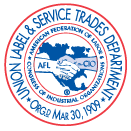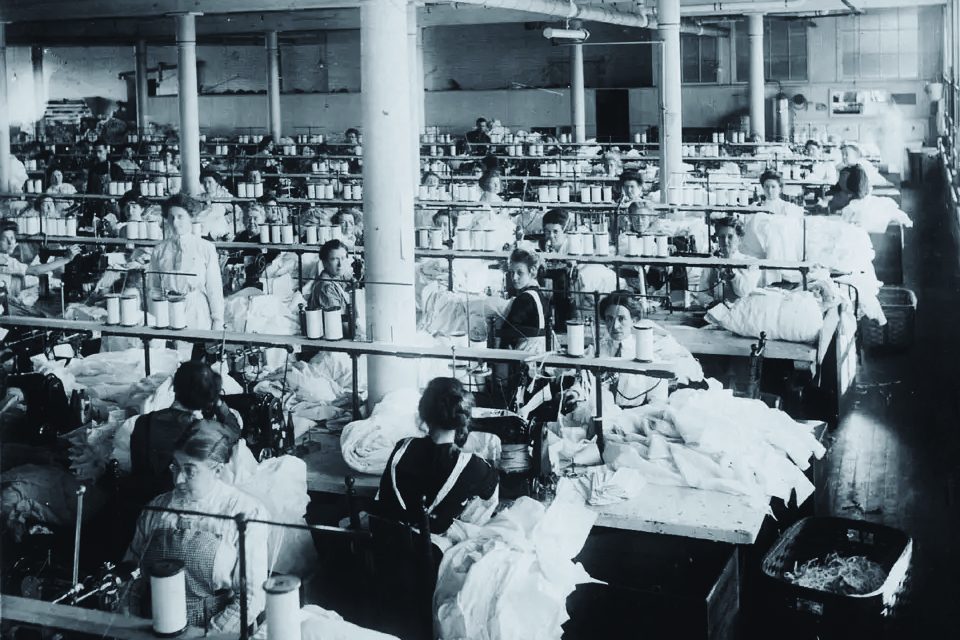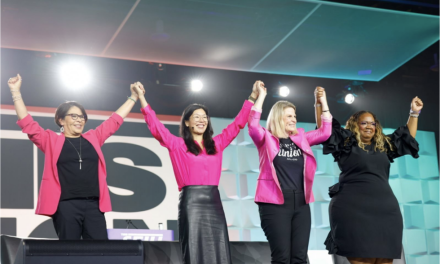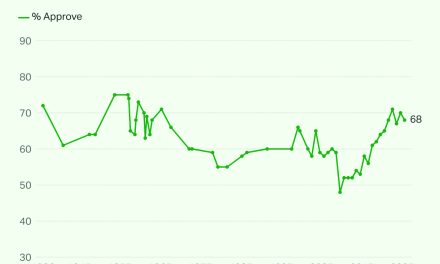Traditionally, labor unions have been male-dominated spaces, both in terms of membership and leadership. Yet, as workplace dynamics evolve and women increasingly enter various sectors, a significant shift has taken place: more women are stepping into leadership roles within unions. This transformation not only mirrors broader societal changes but also brings fresh perspectives to the table. Women leaders in labor unions are championing inclusive, progressive policies that uplift all workers, and create equity and justice in the workplace.
In today’s economic landscape, particularly as the United States grapples with the aftermath of the pandemic and the challenges of the “she-cession” caused by the pandemic, the role of women in unions and their access to collective bargaining is crucial for advancing women’s prosperity. More women labor leaders are key to expanding women’s access to the benefits of unionization.
Trailblazing Women
Kate Mullany, Collar Laundry Union
“You show me the women and I’ll turn them into organizers.”
Kate Mullany was a pioneering labor leader in the 19th century and is considered one of the first women to organize a successful labor union in the United States. She is best known for helping to create the Collar Laundry Union in Troy, New York, in 1864. At the time, many women worked under poor conditions in the city’s booming collar and cuff industry, enduring long hours and low pay. Mullany and her coworkers grew increasingly frustrated. She and around 200 other laundresses organized a strike demanding higher wages and better working conditions. After a week-long strike, they won a 25% pay raise, a significant victory at the time. The Collar Laundry Union became one of the earliest examples of women leading a labor movement in the U.S., and Mullany’s leadership and efforts laid the groundwork for future labor activism among women.
Rose Pesotta and the ILGWU
“Nothing will ever be won by waiting around. You’ve got to put your shoulder to the wheel to get ahead.”
Rose Pesotta was a prominent labor leader who played a key role in organizing garment workers in the early 20th century. Born in Ukraine in 1896, Pesotta immigrated to the United States in 1913 and became deeply involved in the labor movement. She is best known for her work with the International Ladies’ Garment Workers’ Union (ILGWU), where she rose to the position of vice president—the first woman to hold such a high-ranking office in the union.
Pesotta’s contributions to labor organizing were significant. In the 1930s, she led successful strikes and organizing campaigns in various cities, including Los Angeles, where she helped to establish the ILGWU as a major force in the West Coast garment industry. Her efforts were notable for their inclusivity, as she worked closely with immigrant workers and advocated for women’s leadership in the labor movement.
Despite her achievements, Pesotta was frustrated by sexism in her union. Discouraged by the ILGWU’s reluctance to prioritize women’s issues, she eventually resigned from her vice presidency in 1944, though she remained active in labor causes.
Pesotta was also a writer and chronicled her experiences in the labor movement in her autobiography, “Bread Upon the Waters” (1944). Her legacy as a trailblazing woman in the labor movement remains influential, as she fought not only for workers’ rights but also for women’s equality within labor organizations.
Addie L. Wyatt and the United Packinghouse Workers
“I didn’t know what the union was. But I know that I needed help and here was the place that I could get that help. I knew that I wanted to help other workers, and I found out that I could help them by joining with them and making the union strong and powerful enough to bring about change.”
Addie L. Wyatt was a prominent African American labor leader, civil rights activist, and women’s rights advocate who made significant contributions to the labor movement during the 20th century. Born in 1924 in Brookhaven, Mississippi, she moved to Chicago and began working in the meatpacking industry at Armour & Co. in the 1940s. She quickly became involved with the United Packinghouse Workers of America (UPWA), now a part of the UFCW, rising through the ranks to become an international vice president, making her one of the highest-ranking African American women in the labor movement.
Throughout her career, Wyatt advocated for workers’ rights, focusing on the intersection of labor, civil rights, and women’s equality. She worked closely with Dr. Martin Luther King, Jr., and was active in the civil rights movement, emphasizing the importance of labor unions in securing social justice for African Americans. Wyatt was also a strong advocate for gender equality, co-founding the Coalition of Labor Union Women (CLUW) in 1974.
Wyatt’s activism extended beyond her union work. She was a vocal proponent of economic justice and participated in organizing campaigns and protests that addressed racial and gender discrimination in the workplace. Her efforts helped pave the way for more women, particularly women of color, to assume leadership roles in unions and other social justice movements.
In 1984, Wyatt retired as vice president of UFCW International. Her legacy is one of tireless advocacy for marginalized workers and her belief in the power of solidarity across race and gender lines.
Lilly Ledbetter and The Fair Pay Act
“The truth is, I never thought about suing my employer. I thought that they would do the right thing. It was a bitter pill to swallow when I found out they would not.”
Lilly Ledbetter is a vital figure in the fight for equal pay and gender equality in the workplace. After working for nearly 20 years at Goodyear Tire & Rubber Company, Ledbetter discovered she was paid significantly less than her male colleagues for the same work. Ledbetter was a supervisor at Goodyear, so not a union member, but her advocacy resonates as part of the union experience. She challenged pay discrimination and her groundbreaking work culminated in a landmark legal battle that brought attention to the systemic issues facing women in the workforce.
Despite the initial defeat of her case in the U.S. Supreme Court, Ledbetter became a fierce advocate for the Ledbetter Fair Pay Act, signed into law in 2009. This legislation marked a significant change in the landscape of workplace equality, making it easier for women to challenge pay discrimination.
The Current Landscape
In recent years, the number of women in union leadership positions has significantly increased. According to the Bureau of Labor Statistics, the percentage of women union members has steadily risen, with women making up 47.3% of union members as of 2023.
Women leaders are now heading national unions, local chapters, and labor federations across multiple industries. They are at the forefront of labor movements, advocating for better wages, fair working conditions, family leave policies, and protections against harassment and discrimination.
Current Women Labor Leaders
Liz Shuler – AFL-CIO President
As the first woman to lead the AFL-CIO, Liz Shuler represents a milestone in labor union history. Shuler became president in 2021 after the sudden passing of Richard Trumka and has since prioritized diversifying the labor movement. Under her leadership, the AFL-CIO has focused on growing union membership among women and marginalized groups. Shuler has been a fierce advocate for worker protections, collective bargaining, and gig worker rights. She is also driving initiatives to modernize unions and expand into non-traditional sectors like tech.
Sara Nelson – President of the Association of Flight Attendants (AFA-CWA)
Sara Nelson has become a national face of labor activism, especially following the 2019 government shutdown, during which she called for a general strike to end the political impasse. Nelson has long championed the rights of women and working mothers in the aviation industry, advocating for improved pay, better working conditions, and protections against harassment. She is also a prominent voice for women’s rights in male-dominated spaces and is often cited as a potential future leader of the AFL-CIO.
Mary Kay Henry – President of the Service Employees International Union (SEIU)
Mary Kay Henry became SEIU’s first female president in 2010 and has led the union’s efforts to organize low-wage workers, particularly in healthcare, janitorial services, and food service industries. Under Henry’s leadership, SEIU has been at the forefront of the “Fight for $15” campaign, which advocates for a $15 minimum wage, and has played a crucial role in pushing for healthcare reforms and immigrant rights.
Becky Pringle – President of the National Education Association (NEA)
Representing more than 3 million educators, Becky Pringle leads the largest labor union in the U.S. As a Black woman in this influential role, Pringle has made diversity, equity, and inclusion central to her agenda. She has also been a vocal advocate for educational reforms that protect both teachers and students and for investments in public education, particularly in underfunded communities. Pringle’s leadership is key in fighting for gender and racial equity in education.
Randi Weingarten, president of the american federation of teachers (AFT)
The current president of the American Federation of Teachers (AFT), Randi Weingarten, has served in her role since 2008, playing a significant role in shaping labor policy and educational reform in the U.S.
Before becoming the president of the AFT, Weingarten was the first female president of the United Federation of Teachers (UFT) in New York City, the largest local union of the AFT. As one of the highest-profile openly gay labor leaders in the U.S., she is also a prominent voice for LGBTQ+ rights, using her platform to fight for workplace equality and inclusion.
Weingarten is known for her innovative approaches to collective bargaining, negotiating teacher contracts that focused not only on pay and benefits but also on improving student learning conditions and championing the idea of “solution-driven unionism,” where the union actively engages with local communities to solve educational problems and fight for better schools.
Key Statistics and Trends
**Representation Growth:** Women now make up nearly half of union members in the U.S. In 1983, women accounted for just 35% of unionized workers; today that number is close to parity.
**Unionization Trends:** Sectors where women are more highly represented, such as education, healthcare, and service industries, have seen some of the highest rates of unionization efforts. For example, in 2022, 77% of the workforce in the healthcare and education sectors were women, making their role in union organizing essential.
**Pay Equity:** Research shows that women in unions have narrower gender pay gaps compared to their non-union counterparts. In unionized workplaces, women earn on average 94 cents for every dollar a man makes, compared to 82 cents in non-union workplaces.
**A Forward-Thinking Approach**
The increasing visibility of women in labor union leadership is not just a reflection of changing demographics but also an indication of the evolving priorities of the labor movement. Women’s leadership brings a fresh perspective on issues like paid family leave, affordable healthcare, and equal pay, which are essential for creating fairer workplaces. Women leaders are also more likely to champion policies that address issues such as gender-based violence, sexual harassment, and caregiving responsibilities, which disproportionately affect women workers.
The future of labor unions will see more innovative approaches to organizing, as women continue to break into leadership roles in tech, digital platforms, and non-traditional industries.
The rise of women in labor union leadership is reshaping the labor movement for the better.









